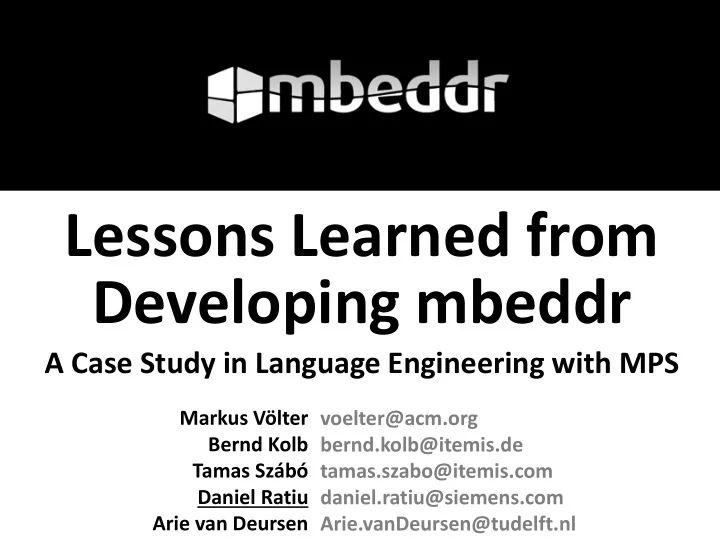

Lessons Learned from Developing mbeddr A Case Study in Language Engineering with MPS Markus Völter voelter@acm.org Bernd Kolb bernd.kolb@itemis.de Tamas Szábó tamas.szabo@itemis.com Daniel Ratiu daniel.ratiu@siemens.com Arie van Deursen Arie.vanDeursen@tudelft.nl
MPS
A Language Workbench – a tool for defining, composing and using ecosystems of languages.
Open Source Apache 2.0 http://jetbrains.com/mps
V 2017.2 is current V 2017.3 released later in 2017
[Language Workbench] Comprehensive Support for many aspects of Language Definition. + Refactorings, Find Usages, Syntax Coloring, Debugging, Language Evolution and Models Migration, Configuration Management, ...
users
[Projectional Editing] Parsing
[Projectional Editing] Parsing Projectional Editing
[Projectional Editing] Syntactic Flexibility Regular Code/Text Mathematical Tables Graphical
[Projectional Editing] Syntactic Flexibility Regular Code/Text Mathematical Tables Graphical
[Projectional Editing] Language Composition L2 L1 Separate Files In One File Type System Type System Transformation Transformation Constraints Constraints Syntax IDE
[Projectional Editing] Language Composition L2 L1 Separate Files In One File Type System Type System Transformation Transformation Constraints Constraints Syntax IDE 50+ extensions to C 10+ extensions to requirements lang.
Origins „Language Workbenches for Embedded Systems“ Research project publicly funded between 2011 – 2013 Goal: show that it is cost effective to build domain specific languages and tools even for small companies or teams … by using language workbenches
An extensible set of integrated languages for embedded software engineering.
Components (mbeddr)
State Machines (mbeddr)
Testing & State M. (mbeddr)
Mocks & Units (mbeddr)
Product Lines (mbeddr)
Registers (smart meter)
Interrupts (smart meter)
Messages (smart meter)
Size of the System
Variety of Languages
Dev Timeline
Homepage www.mbeddr.com Open Source, Eclipse Public License https://github.com/mbeddr/mbeddr.core
Research Findings
RQ1: Modularity Is it practically feasible to define a modular set of languages of the size of mbeddr?
Modularity Language Composition Mechanisms used
Modularity OO-style composition for structure and syntax
Modularity Fine-grained nesting
Modularity Modular semantics/generators
Modularity Wrap Up mbeddr’s 34 extensions to C are a clear indication that MPS’ language modularity works. Modularity is useful for language understanding, testing and reuse. In rare cases, modularity is compromised by necessary changes to the base language and unwanted dependencies between independent extensions. Currently there is no way to detect (unwanted) semantic interactions between independent language extensions through analysis of their transformations.
RQ2: Projection What is the contribution of projectional editing to the success of mbeddr?
Projection Variety of notations used in mbeddr Regular Code/Text Mathematical Tables Graphical
Projection Wrap Up The two main benefits of projectional editing – language modularity and a range of combinable notations – have been used extensively in mbeddr. The anticipated benefits have been observed. The editor can be flexibly extended with new notational styles with acceptable effort, as exemplified by the support for math, tables and diagrams. The ability to use multiple and partial projections must be further improved by integrating with other language aspects, in particular, editor actions and type checks.
RQ3: Complexity How effective are MPS’ mechanisms for managing the complexity inherent in language development?
Complexity Wrap Up The approach of using a DSL for each language aspect works well based on our experience, even though some aspects are missing and some are not declarative enoughto support meaningful analyses. The support for debugging is spotty: it works well for transformations, but debugging generator macros, behaviors and type system rules is very tedious. The ability to extend MPS’ language definition DSLs with MPS itself is a powerful approach for managing complexity, and we have used it extensively, even though it has some limitations.
RQ4: Scalability What are the performance and scalability implications?
Scalability Generator Performance
Scalability Wrap Up If attention is paid to the size of roots and the distribution of code over multiple models, then systems of significantsize can be built with MPS. The performance of the type system (as it is evaluated in realtime in the editor) and support for cross-model generation are the two most critical ways of improving MPS performance. During the development of languages we have not run into any problems regarding performance or scalability (of editor, type system or generator definitions).
RQ5: Process What are the interactions with the development process?
Process Language Testing Support
Process Wrap Up Except for the missing test support for model migrations and single-step transformations, language testing works well, and we have achieved good coverage as demonstrated by a stable code base. We have successfully integrated mbeddr’s build, test and packaging with the Teamcity CI server, but the effort to get there was significant, partially as a consequence of the inadequacy of MPS’ build language. Migrating instance models as the underlying languages change incompatibly is feasible with manually scripted migrations and their automatic execution based on implicitly-maintained language version numbers.
Back to the Present
Today “new” developments Our SoSym paper “ends” in 12.2015
Beyond mbeddr …
mbeddr today is 20% bigger than in 12.2015 ESD doubles the size of mbeddr today All Findings Remain Valid
Thank you! www.mbeddr.com Open Source, Eclipse Public License https://github.com/mbeddr/mbeddr.core
Recommend
More recommend